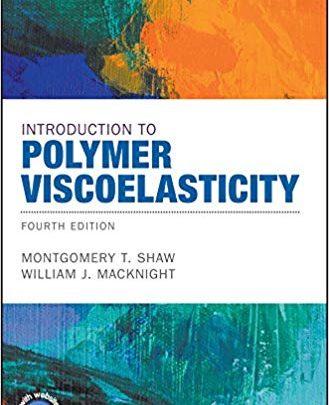دانلود کتاب Introduction to Polymer Viscoelasticity نسخه 4

خرید ایبوک Introduction to Polymer Viscoelasticity, 4th Edition
برای دانلود PDF Original کتاب Introduction to Polymer Viscoelasticity, 4th Edition نسخه 4 ام با عنوان مقدمه ای بر پلیمر ویسکوالاستیسیته بر روی کلید خرید در انتهای صفحه کلیک کنید. پس از اتصال به درگاه پرداخت و تکمیل مراحل خرید، لینک دانلود ایمیل می شود.
در صورتی که نیاز به دانلود هر کتابی از آمازون یا گوگل بوک دارید، فقط کافیست ادرس اینترنتی کتاب را از سایت www.amazon.com و یا books.google.com برای ما ارسال کنید (راههای ارتباطی در صفحه تماس با گیگاپیپر ). پس از بررسی، هزینه ان اعلام می شود. پس از واریز نسخه الکترونیکی ارسال می شود.

Introduction to Polymer Viscoelasticity 4th Edition
by Montgomery T. Shaw (Author), William J. MacKnight (Author)
Hardcover: 384 pages
Publisher: Wiley; 4 edition (July 24, 2018)
Language: English
ISBN-10: 9781119181804
ISBN-13: 978-1119181804
لینک:https://www.wiley.com/en-at/Introduction+to+Polymer+Viscoelasticity%2C+4th+Edition-p-9781119181804
For Download Please Contact Us :
Price : 25$
دانلود رایگان ایبوک Introduction to Polymer Viscoelasticity, 4th Edition
برای اطمینان از کیفیت کتاب ، چند صفحه ابتدایی دانلود کتاب مقدمه ای بر پلیمر ویسکوالاستیسیته بصورت رایگان قرار داده شده است.
درباره کتاب Introduction to Polymer Viscoelasticity, 4th Edition
Completely revised and updated, the fourth edition of this classic text continues to offer the reader a thorough understanding of viscoelastic behavior, essential for the proper utilization of polymers. Explains principles, corresponding equations, and experimental methods with supporting real-life applications Adds coverage of measurement techniques (nano-indentation, atomic force microscopy (AFM), and diffusing wave spectroscopy (DWS)), biopolymer viscoelasticity, and the relationship between mechanical polymer properties and viscoelastic functions Has two new ections to address modern areas of viscoelastic measurement: large amplitude oscillatory shear (LAOS) and microrheology Includes problems in the text and an Instructor’s Manual (including solutions) available for adopting professors Prior edition reviews: “The book is clear written and…[is] appropriate for students in introductory undergraduate courses and for others wanting introduction to the fundamentals of the subject.” (CHOICE, December 2005); “This book is invariably well written, logically organized and easy to follow…I highly recommend this book to anyone studying polymer viscoelasticity.” (Polymer News, December 2005)
دانلود کتاب مقدمه ای بر پلیمر ویسکوالاستیسیته
فهرست مطالب کتاب Introduction to Polymer Viscoelasticity, 4th Edition
Cover; Title Page; Copyright; Contents; Preface to the Fourth Edition; Preface to the Third Edition; Preface to the Second Edition; Preface to the First Edition; About the Companion Website; 1. Introduction; PROBLEMS; GENERAL REFERENCE TEXTS; REFERENCES; 2. Phenomenological Treatment of Viscoelasticity; A. ELASTIC MODULUS; B. TRANSIENT EXPERIMENTS; C. DYNAMIC EXPERIMENTS; 1. Low-Strain Measurements; 2. Large Amplitude Oscillatory Shear (LAOS); 3. Microrheology; D. BOLTZMANN SUPERPOSITION PRINCIPLE; E. RELATIONSHIP BETWEEN THE CREEP COMPLIANCE AND THE STRESS RELAXATION MODULUS F. RELATIONSHIP BETWEEN STATIC AND DYNAMIC PROPERTIESAPPENDIX 2-1. Connecting Creep Compliance and Stress Relaxation Modulus Using Laplace Transforms; APPENDIX 2-2. Borel’s Theorem; APPENDIX 2-3. Geometries for the Measurement of Viscoelastic Functions; 1. Linear Motion Geometries; 2. Rotational Motion Geometries; PROBLEMS; REFERENCES; 3. Viscoelastic Models; A. MECHANICAL ELEMENTS; 1. Maxwell Model; 2. Voigt Model; 3. Generalized Maxwell Model; 4. Voigt-Kelvin model; B. DISTRIBUTIONS OF RELAXATION AND RETARDATION TIMES; C. MOLECULAR THEORIES-THE ROUSE MODEL D. APPLICATION OF FLEXIBLE-CHAIN MODELS TO SOLUTIONSE. THE ZIMM MODIFICATION; F. EXTENSION TO BULK POLYMER; G. REPTATION; APPENDIX 3-1: MANIPULATION OF THE ROUSE MATRIX; PROBLEMS; REFERENCES; 4. Time-Temperature Correspondence; A. FOUR REGIONS OF VISCOELASTIC BEHAVIOR; B. TIME-TEMPERATURE SUPERPOSITION; C. MASTER CURVES; D. THE WLF EQUATION; E. MOLECULAR INTERPRETATION OF VISCOELASTIC RESPONSE; PROBLEMS; REFERENCES; 5. Transitions and Relaxation in Amorphous Polymers; A. PHENOMENOLOGY OF THE GLASS TRANSITION; B. THEORIES OF THE GLASS TRANSITION; 1. Free-Volume Theory; 2. Thermodynamic Theory 3. Kinetic TheoriesC. STRUCTURAL PARAMETERS AFFECTING THE GLASS TRANSITION; D. RELAXATIONS IN THE GLASSY STATE; E. RELAXATION PROCESSES IN NETWORKS; 1. Physical Relaxation; 2. Chemical Processes; F. BIOPOLYMER VISCOELASTICITY; 1. Biopolymer Sources; 2. Humidity Control; 3. Examples of Biopolymer Viscoelastic Response; PROBLEMS; REFERENCES; 6. Elasticity of Rubbery Networks; A. THERMODYNAMIC TREATMENT; B. STATISTICAL TREATMENT; 1. Derivation; 2. Energy Contribution; C. PHENOMENOLOGICAL TREATMENT; D. FACTORS AFFECTING RUBBER ELASTICITY; 1. Effect of Degree of Crosslinking; 2. Effect of Swelling 3. Effect of Fillers4. Effect of Strain-Induced Crystallization; APPENDIX 6-1. Statistics of a Polymer Chain; APPENDIX 6-2. Equation of State for a Polymer Chain; PROBLEMS; REFERENCES; 7. Dielectric and NMR Methods; A. DIELECTRIC METHODS; 1. Phenomenology; 2. Molecular Interpretation of Dielectric Constant; 3. Interfacial Polarization; 4. Application to Polymers; 5. Experimental Methods; 6. Application of Dielectric Relaxation to Poly(methylmethacrylate); 7. Comparisons between Mechanical and Dielectric Relaxation for Polymers; B. NUCLEAR MAGNETIC RESONANCE METHODS; PROBLEMS; REFERENCES